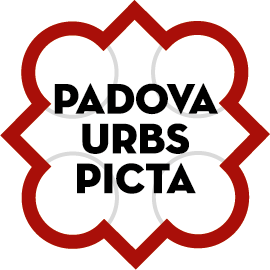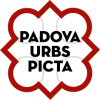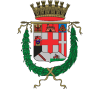The Piazze
Starting-point: Piazza dei Signori (position on map: 18)
We start from one of Padua’s historic city squares, which are known locally simply as le piazze. Lined with porticoed arcades, this square is, during weekdays, home to a bustling market, and on warm evenings a lively meeting-point for those having their aperitivo. With the Clock Tower behind you, if you look right you see the unmistakable Loggia della Gran Guardia, and following along that side of the piazza you then enter the street which runs by the side of the Church of San Clemente up to the east side of the Palazzo della Ragione. The full magnificence of this structure then becomes visible when you turn right into Piazza delle Erbe (map: 16). Since the Middle Ages, this has been home every morning to a fruit and vegetable market, and the stall-holders are still very vocal in promoting their wares. In winter time, for example, “Treviso, Chioggia, Verona and Castelfranco!” may sound like a list of town names but is the range of varieties of red radicchio on offer.
Within Padua, the Palazzo della Ragione (map: 15) is known simply as Il Salone – just as the Basilica of St. Anthony or Palazzo del Bò (which houses the university) are known simply as Il Santo and Il Bò. The spaces within the arcades underneath the vast raised Salone are also occupied by shops and stalls. In fact, there have been market stalls in these arcades since the end of the sixteenth century, and the quality of the produce on offer makes a visit here a must for all those who appreciate good food.
The Listòn
Coming out on the other side of Palazzo della Ragione, you are in Piazza della Frutta (map:17), which is home to another open-air market. Then, turning right into Via Oberdan, you come into the Listòn, an area for strolling and shopping (the name comes from the large marble slabs – listoni – used to pave it). To your right as you emerge into the Listòn is the Palazzo degli Anziani [Elders’ Palace], which is the oldest part of the complex of buildings that make up City Hall: built in 1285 and then enlarged in 1523, it has a portico decorated with the crests of various podestà [city governors]. The Tower that rises above the building was built in 1296 and originally stood somewhat taller (it was lowered in 1939): as the frescoes in the Chapel of the Blessed Luca Belludi in the Basilica of St. Anthony demonstrate, a large number of the palazzi in medieval and Renaissance Padua had defensive towers. Continuing to the right, you come to Palazzo Moroni (map: 13), the core of the City Hall, which stands directly opposite Palazzo del Bò, the historic seat of Padua University. If, however, you turn left instead of right, you see the famous “café without doors”: Caffè Pedrocchi (map 14). This has played a major part in the life of the city, and it is well worth pausing here for a drink and snack. After all, this is one of the few historic cafés that has preserved its interiors.
If you now continue leftwards down the Listòn, on the right you soon see Piazza Cavour, home to the Galleria Civica (map: 13. For information on the exhibitions at Galleria Civica, call the offices of the Musei Civici – 049-8204508 – or look at the “events” section of this website). On the opposite side of the Listòn to Piazza Cavour is the opening to Via Sant’Andrea, which leads to the church from which it takes its name. Here stands the so-called Colonna della Gatta [Cat’s Column], with one of famous sculptures of cats (gatte) to be found at different points around the city. There are various stories to explain their origins. One tradition has it that they were intended to mock the Venetians’ obsession with marking their military victories by erecting statues of lions all over the place.
The Santa Lucia Neighbourhood
Continuing down Via Sant’Andrea you come to the Palace of Ezzelino, which was the home of Ezzelino III Romano, a lieutenant of the emperor Frederic II and a member of a dynasty whose bloody rule would extend over most of the central area of the Veneto in the twelfth century. This building is one of the few surviving traces of the Santa Lucia district which grew up here during the Middle Ages. Unfortunately, the area subsequently went into decline and during the Fascist era was largely bulldozed to make way for Piazza Insurrezione (flanked by the Bourse and the Chamber of Commerce) and the streets leading into it.
Passing under the large vault of the Palace of Ezzelino, you enter Via Santa Lucia, and then, turning left, you come to the Oratorio di San Rocco and the church which gives it its name (map:30). Continuing down Via Santa Lucia, you cross Via Dante and enter a narrow alleyway that leads to the Church of San Nicolò (map:22), sitting in a very atmospheric square. With the church at your back, you can glimpse Teatro Verdi (map 21); designed by Japelli, this was built at the end of the eighteenth century, when the Italian passion for opera was at its height.
Strà Maggiore and Ponte Molino
Turning right into Corso Milano and then walking towards Porta Molin, you come to Via Dante, on the left. At the time of the Carraresi, this was where the palace stables were located. Up to the early twentieth century this street was still called Strà Maggiore, both because of the beauty of the houses lining it and because it had always been the major north-south axis through the city. In the street you can still see some of the palazzi which earned it its reputation, One house here dates from 1383, and to the right of it is a palazzo which was modernised in 1793 but still kept its medieval tower; probably dating from around 1100, that tower is the oldest in the city.
To the left you come to the church of Sant’Agnese, which has been deconsecrated since the late 1920s but dates from the twelfth century. The round bell-tower to the side of the church is Romanesque and one of the oldest in the city; the main doorway is sixteenth-century, even though the friezes that decorate the interior of that portal are fifteenth-century. Nowadays the building serves as a garage.
The entire zone was once notorious for its brothels, hence the local expression “andare a Sant’Agnese” [To go to St. Agnes] On the right, as you pass down Via Dante, is the casino Fasolo (casino being a common term for a brothel), followed by the Palazzo Cittadella-Vigodarzere, which belonged to one of the most powerful families in the city. At the end of the street you come to Ponte Molino [The Molino Mill] and Porta Molino [Mill Gateway], beyond which you come to Piazza Petrarca, which is dominated by the Basilica della Madonna del Carmine (map:24).
From here it is easy to get to the car parks by taking the “Diretto Piazze” bus at the Via Dante stop. You can also walk right back up the street to Ponte Molino. If you then continue in a straight line you get to your starting-point: Piazza dei Signori (map: 18)












